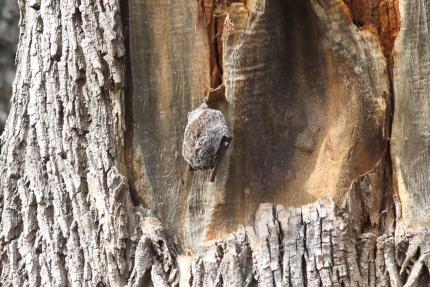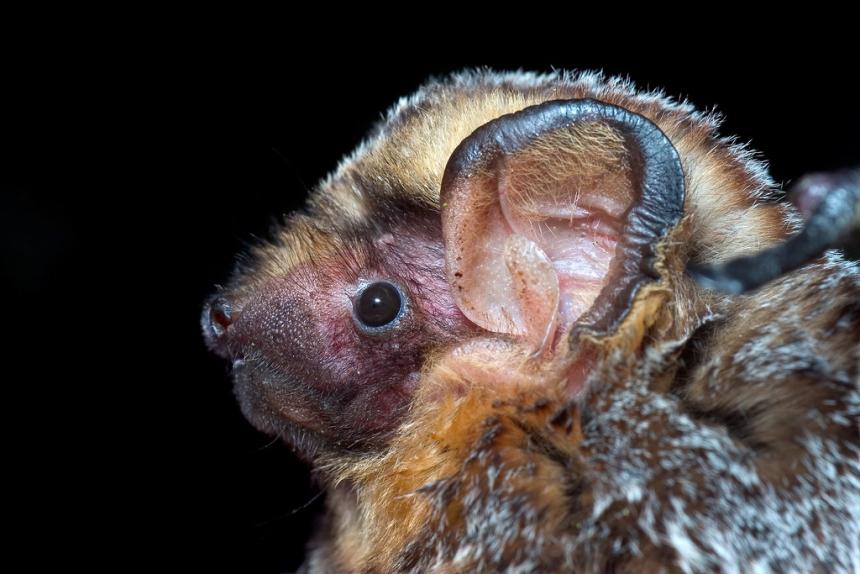The hoary bat is a widely distributed migratory bat that is vulnerable to mortality from wind turbines during migration. It also faces threats from habitat alteration throughout its range.
White-nose syndrome is a deadly fungal disease that has been confirmed in some Washington bat species, but to date, no diagnostic evidence of the disease has been detected in hoary bats. It is unclear which species of bats may be vulnerable to this disease in Washington. This disease does not affect humans, livestock, or other wildlife.
If you find sick or dead bats or notice bats acting strangely, such as flying outside in the day or in freezing weather, please report your sighting online or call WDFW at 360-902-2515. Do not handle bats that appear sick or injured.
Description and Range
Physical description
The hoary bat is the largest bat in Washington; they are 5 to 6 inches long and have a wingspan of about 15 inches. The fur is a mixture of yellowish-brown, dark brown, and white, giving it a distinctive frosty or “hoary” appearance. Individual hairs on the back have four distinct color bands, with blackish-brown at the base followed by yellowish-brown, blackish-brown, and silvery white at the tips. Yellow or white fur occurs on the shoulders and wrists. Yellow fur also encircles the ears and is present on the throat and underside of the wing membranes. Wing membranes are blackish-brown with paler brown strips along the forearm and metacarpals. Wings are long and narrow. The upper surface of the tail membrane is densely furred. Ears are short and rounded with a dark brown or black margin, and the tragus is short and broad. The calcar (ankle spur) has a narrow keel (tail flap).
Ecology and life history
Habitat includes primarily deciduous and coniferous forests and woodlands, including areas altered by humans.

Roost sites are usually in tree foliage 10 to 16 feet above the ground, with dense foliage above and open flying room below, often at the edge of clearings. Males roost solitarily. In Saskatchewan, reproductive females roosted on the south (especially southeast) side of white spruce trees, where wind speed was reduced.
Hoary bats are relatively fast fliers with limited maneuverability that tend to favor open areas for foraging. They feed chiefly on large moths and to a lesser extent on other insects.
Hoary bats roost in the open foliage of deciduous and coniferous trees. Unlike most bat species that aggregate in maternity colonies, females with young roost solitarily and select trees that provide shelter from wind, stable sunlight exposure, and are near a clearing.
Females typically give birth to one litter of twins in May and June, although up to four pups have been documented. Young are slow to develop and are capable of sustained flight at about five weeks of age. However, they remain with their mothers for several weeks after they begin flying.
Geographic range
Hoary bats are the most widely distributed bat species in North America and are found throughout Washington in forested areas with associated clearings, from sea level to at least 5300 feet. They occur in the Columbia Basin if trees are available and sometimes in arid steppe during migration. Hoary bats are resident in summer and considered to be a migratory species.
In Washington, migrating individuals have been documented in spring and fall; however a few records document presence in winter. Winter range is unknown, but presumed to be located in southern California and Mexico.
For a map of range-wide distribution and conservation status of this species, check out NatureServe Explorer.
Climate vulnerability
Sensitivity to climate change
High
*NOTE: In general the CCVA methodology does not include human responses to climate change in sensitivity rankings. However because wind energy development is a direct and expanding response, and has an outsized impact on this species, it is included here. Without wind energy development as a factor, sensitivity would be LOW. Hoary bats are highly migratory. Collisions with wind turbines are a major mortality source for migrating individuals, thus the expansion of wind energy facilities in response to climate change will likely have a strongly negative impact on this species. Additionally, the hoary bat displays low physiological sensitivity with a generalist's diet and a broad geographic distribution in both coniferous and deciduous forests across a wide temperature gradient from 0 to 22°C at elevations from 0 to 1,620 m in the Pacific Northwest. Hoary bats are probably sensitive to the structural changes in forests caused by logging, fire, and increased insect outbreaks, which would reduce roosting and possibly foraging opportunities. Thus, altered forest fire regimes associated with climate change could degrade or eliminate roosting habitat on a local scale. Also, warmer, drier conditions could affect insect availability and reduce drinking sources for the bats, which could affect survival and reproductive output. Large numbers of individuals migrate through the Columbia Basin, thus hotter, drier conditions in this region could negatively affect the migration behavior of a significant portion of the population passing through Washington.
Exposure to climate change
Moderate
- Wind energy development (human response)
- Altered fire regimes
- Changes in precipitation
- Drought
- Increased forest insect outbreaks
Conservation
Conservation Threats and Actions Needed
- Energy development and distribution
- Threat: The species is highly susceptible to mortality from wind energy facilities.
- Action Needed: Monitor wind farms for mortality; avoid siting wind farms in areas of high bat activity, and encourage power companies to curtail wind turbine use during periods of low wind speeds.
- Fish and wildlife habitat loss or degradation
- Threat: Logging and conversion to younger even-aged forest stands likely reduces the quality of roosting habitat.
- Action Needed: Encourage logging techniques that maintain complex forest structure and large trees and snags.
- Resource information collection needs
- Threat: Better information is needed on migration behavior and routes, and the extent that individuals winter in Washington.
- Action Needed: Conduct research on migration patterns.
- Threat: Better information is needed on habitat requirements and population status.
- Action Needed: Conduct research on habitat requirements and population status.
See the Climate vulnerability section for information about the threats posed by climate change to this species.
Preventing conflict
For some people bats don't present a problem. For others, bats can be a worry, especially when they become unwanted guests in an attic, inside a wall of a home, or inside the home itself.
Unlike rodents, bats only have small teeth for eating insects, so they do not gnaw holes in walls, shred material for nests, chew electrical wiring, or cause structural damage to buildings. Damage caused by bats is usually minimal, but they can be noisy and alarming, and the smell of bats and their droppings can be offensive. It is possible to learn to coexist with bats, and to benefit from their presence. Learn more on our Living with Wildlife: Bats webpage.
Resources
References
Hayes, G. and G. J. Wiles. 2013. Washington bat conservation plan. Washington Department of Fish and Wildlife, Olympia, Washington.
Klug, B. J., D. A. Goldsmith and R. M. R. Barclay. 2012. Roost selection by the solitary, foliage-roosting hoary bat (Lasiurus cinereus) during lactation. Canadian Journal of Zoology 90:239-336.
Nagorsen, D. W. and R. M. Brigham. 1993. The bats of British Columbia. UBC Press, Vancouver, British Columbia.
Willis, C. K. R. and R. M. Brigham. 2005. Physiological and ecological aspects of roost selection by reproductive female hoary bats (Lasiurus cinereus). Journal of Mammalogy 8:85-94.
